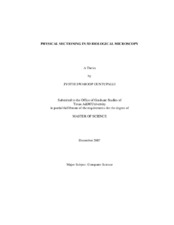| dc.description.abstract | Our ability to analyze the microstructure of biological tissue in three dimensions
(3D) has proven invaluable in modeling its functionality, and therefore providing a better
understanding of the basic mechanisms of life. Volumetric imaging of tissue at the
cellular level, using serial imaging of consecutive tissue sections, provides such ability to
acquire microstructure in 3D. Three-dimensional light microscopy in biology can be
broadly classified as using either optical sectioning or physical sectioning. Due to the
inherent limitations on the depth resolution in optical sectioning, and the recent
introduction of novel techniques, physical sectioning has become the sought-out method
to obtain high-resolution volumetric tissue structure data. To meet this demand with
increased processing speed in 3D biological imaging, this thesis provides an engineering
study and formulation of the tissue sectioning process. The knife-edge scanning
microscopy (KESM), a novel physical sectioning and imaging instrument developed in
the Brain Networks Laboratory at Texas A&M University, has been used for the purpose
of this study. However, the modes of characterizing chatter and its measurement are
equally applicable to all current variants of 3D biological microscopy using physical sectioning.
We focus on chatter in the physical sectioning process, principally characterizing it
by its geometric and optical attributes. Some important nonlinear dynamical models of
chatter in the sectioning process, drawn from the metal machining literature, are
introduced and compared with observed measurements of chatter in the tissue cutting
process. To understand the effects of the embedding polymer on tissue sectioning, we
discuss methods to characterize the polymer material and present polymer
measurements. Image processing techniques are introduced as a method to abate chatter
artifacts in the volumetric data that has already been obtained. Ultra-precise machining
techniques, using (1) free-form nanomachining and (2) an oscillating knife, are
introduced as potential ways to acquire chatter-free higher-resolution volumetric data in
less time. Finally, conclusions of our study and future work conclude the thesis.
In this thesis, we conclude that to achieve ultrathin sectioning and high-resolution
imaging, embedded plastic should be soft. To overcome the machining defects of soft
plastics, we suggested free-form nanomachining and sectioning with an oscillating knife. | en |


